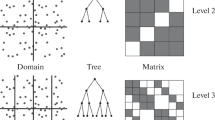Abstract
The mosaic-skeleton method was bred in a simple observation that rather large blocks in very large matrices coming from integral formulations can be approximated accurately by a sum of just few rank-one matrices (skeletons). These blocks might correspond to a region where the kernel is smooth enough, and anyway it can be a region where the kernel is approximated by a short sum of separable functions (functional skeletons). Since the effect of approximations is like that of having small-rank matrices, we find it pertinent to say about mosaic ranks of a matrix which turn out to be pretty small for many nonsingular matrices.
On the first stage, the method builds up an appropriate mosaic partitioning using the concept of a tree of clusters and some extra information rather than the matrix entries (related to the mesh). On the second stage, it approximates every allowed block by skeletons using the entries of some rather small cross which is chosen by an adaptive procedure. We focus chiefly on some aspects of practical implementation and numerical examples on which the approximation time was found to grow almost linearly in the matrix size.
Similar content being viewed by others
Explore related subjects
Discover the latest articles, news and stories from top researchers in related subjects.Author information
Authors and Affiliations
Additional information
Received February 13, 1999; revised October 26, 1999
Rights and permissions
About this article
Cite this article
Tyrtyshnikov, E. Incomplete Cross Approximation in the Mosaic-Skeleton Method. Computing 64, 367–380 (2000). https://doi.org/10.1007/s006070070031
Issue Date:
DOI: https://doi.org/10.1007/s006070070031




